Effective Strategies for Managing Birds in Trees
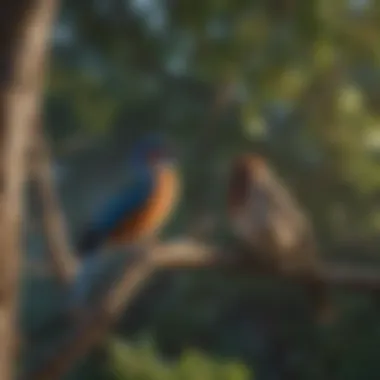
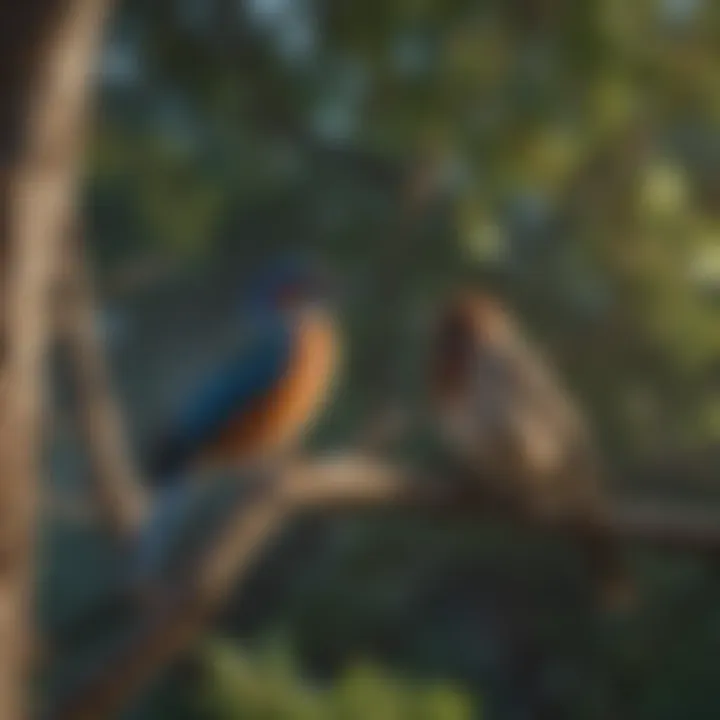
Intro
Birds often become a topic of discussion among homeowners and nature enthusiasts alike. Their presence in trees brings a sense of life to the environment, yet it can also give rise to challenges. These challenges include potential harm to vegetation, disruption of local ecosystems, and, at times, nuisance behaviors near residences. Understanding the dynamics of birds that inhabit trees is essential for effective management strategies that promote a balanced coexistence.
This article delves into the various factors at play. It provides insights into the ecological roles many birds play in the environment, identifies common bird species found in urban and suburban landscapes, and presents practical and humane methods for managing their populations. Strategies will encompass habitat modification, as well as humane deterrents, ensuring the approach prioritizes ecological welfare.
Understanding the Pest
Identification
To manage birds effectively, the first step is understanding which species are present in the area. Common birds that often inhabit trees include sparrows, starlings, and pigeons. Each species has its distinct behaviors and possible impact on the ecosystem. This identification can be conducted through visual observation or by using resources such as birding apps.
Life Cycle
Understanding the life cycle of these birds is crucial in managing their populations. Most common tree-dwelling birds have a similar life cycle that includes egg-laying, hatching, and maturation. For instance, sparrows tend to breed several times throughout the year, resulting in multiple nests in a single season. This breeding behavior can lead to larger populations if not managed properly. Observing the timing of nesting can provide insights into the best times for implementing deterrents or interventions.
Pest Prevention Strategies
Environment Modification
One effective tactic for managing birds is environment modification. This involves altering the physical surroundings to make it less attractive to birds. Simple changes such as removing easy food sources, including unsecured trash or unripe fruits, can deter birds from frequenting particular areas. Planting certain native vegetation that does not produce berries can also limit attracting birds.
Physical Barriers
Physical barriers can be another useful strategy. Installing bird spikes or netting on specific trees can prevent birds from roosting and nesting in undesirable locations. These methods are especially effective in urban areas where birds congregate commonly. It is advisable to ensure that any barriers used do not harm the birds or other wildlife.
Control Methods
Biological Control
In some cases, biological control can be a viable option. This might involve introducing natural predators that do not disrupt the ecosystem. However, careful consideration should be given to the local ecology to prevent unforeseen consequences.
Chemical Control
While chemical control is generally not recommended due to its potential harm to the environment and non-target species, some may still consider this option. In these instances, careful adherence to guidelines and regulations is essential. Alternatives that do not require chemicals are often more sustainable and safer for the environment. Evaluating the necessity of such methods is important before proceeding.
Effective management of birds in trees requires a combination of understanding their behaviors, modifying the environment, and implementing both humane and ecological strategies.
Managing birds in trees can be challenging but also rewarding when approached with knowledge and care. It is feasible to create environments where both birds and humans can thrive without causing significant disruption to either party.
Understanding the Role of Birds in Ecosystems
Beneficial Aspects of Birds
Birds provide several key benefits that are often overlooked. Firstly, they engage in pest control. Many bird species consume insects and larvae that may otherwise damage plants and crops. For instance, insectivorous birds help keep the populations of harmful pests in check, reducing the need for chemical pesticides.
Moreover, birds are essential for pollination and seed dispersal. Species like hummingbirds and certain songbirds move pollen from one flower to another. This process is crucial for the reproduction of many plants. Similarly, birds that consume fruits often disperse seeds over large areas, aiding in forest regeneration and maintaining plant biodiversity.
Additionally, their manure acts as a natural fertilizer that enriches soil nutrients, promoting healthier plant growth. Therefore, recognizing these beneficial aspects is important when considering bird management strategies. Ignoring these roles can lead to unintended ecological consequences.
Negative Impacts of Birds on Landscaping
While birds offer many benefits, they can also pose significant challenges, especially in residential areas. Certain species are known to cause damage to trees and plants. For example, woodpeckers may drill into tree bark in search of insects, leading to potential harm or death of the tree. Similarly, some birds will peck at fruits and flowers, which can lead to a decline in plant health and appearance.
Nuisance behaviors are another concern. Flocks of birds can create noise pollution, disrupt outdoor activities, and even pose health risks due to the accumulation of droppings. Moreover, larger bird species like pigeons are notorious for damaging roofs and gutters, leading to costly repairs.
Understanding these negative impacts is essential for formulating effective management strategies. It is crucial to strike a balance that allows birds to thrive without permitting them to compromise the landscaping and aesthetic appeal of residential environments.
Common Bird Species Found in Trees
Understanding the bird species that inhabit trees is crucial for effective management strategies. Different birds bring various characteristics and behaviors that can impact both the ecosystems and human environments. Recognizing these species aids in tailoring specific management practices that align with ecological balance, thus reducing potential nuisances while preserving the benefits birds provide. This section will delve into identifying common problematic avian species, as well as understanding their behaviors related to nesting and feeding.
Identifying Problematic Species
Sparrows
Sparrows are among the most common birds encountered in urban and suburban landscapes. Their adaptability to various environments often results in large populations. A key characteristic of sparrows is their social behavior; they are frequently found in flocks. This can be advantageous since they aid in pollination and seed dispersal. However, sparrows also contribute to damage by eating seeds, fruits, and saplings, which can harm landscaping efforts. Their prevalent presence makes them a focal species for discussions of bird management.
Advantages of managing sparrows include control over their populations which can mitigate the damages they may cause to ornamental plants and gardens.
Starlings
Starlings are notable for their striking appearance and remarkable flocking behavior. They often gather in large numbers, which can create a significant nuisance in both residential and commercial areas. Starlings primarily feed on insects and fruit, which can lead to negative impacts on crops and gardens. Their aggressive nature can displace smaller native birds, further complicating local ecosystems.
Starlings can be both a challenge and advantage; on one hand, they fit well in urban settings and drive pest control by eating insects, but their management becomes essential when they start causing damage.
Pigeons
Pigeons are often seen in urban areas and are known for their adaptability. They are strong fliers and can find food easily, which allows them to thrive among human activities. On the downside, they can pose health risks due to droppings that may carry diseases. Pigeons often congregate in large numbers, creating issues of noise and mess in public spaces and residential properties.
While pigeons can act like natural foragers and help control pest populations, their presence necessitates management strategies to minimize health risks and property damage.
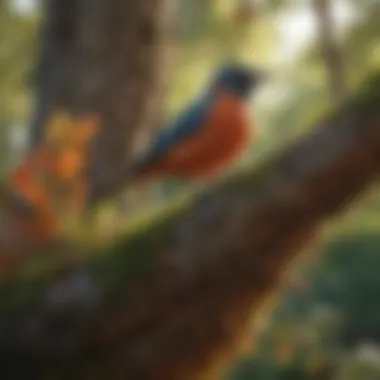

Understanding Bird Behavior
Nesting Habits
Bird nesting habits vary widely among species and significantly affect their populations and behaviors. Many tree-dwelling species, such as sparrows and starlings, often choose urban environments because of the abundance of nesting sites. The nesting season typically sees increased activity, as birds defend territories and raise young. Understanding these habits is essential for effective management.
For example, knowing when birds nest helps owners plan their landscaping efforts to avoid destroying nests during sensitive times. Furthermore, creating safer nesting environments can encourage predatory species, maintaining balance in the ecosystem.
Feeding Preferences
Feeding preferences among bird species dictate where they will settle and thrive. Some birds feed on insects, while others prefer seeds, fruits, or flowers. This behavior is influenced by the availability of resources in their environment.
For example, sparrows have a diverse diet, which allows them to adapt on various terrains. In contrast, starlings may heavily impact certain crops when their feeding is not managed. Understanding specific feeding habits can help promote cohabitation strategies, like planting native species that attract beneficial birds while deterring those that become problematic.
Evaluating the Need for Bird Management
Understanding the necessity for bird management in tree habitats is crucial for homeowners and those responsible for landscaping. Birds can provide significant ecological benefits, but they can also pose challenges. Identifying when it is time to implement management strategies can help mitigate negative impacts while preserving the avian community.
Assessing the need for bird management involves careful observation and analysis of the situation. Homeowners should consider their landscape, the behavior of local bird species, and any adverse effects observed. Effective evaluation can lead to timely interventions that ensure the health of both the trees and the surrounding environment.
Assessing Damage and Nuisance Levels
To determine if birds are causing damage necessitates a systematic approach. First, conduct thorough inspections of the landscape. Look for signs of vegetation stress, such as
- Defoliation: Leaves removed from branches may indicate feeding behavior.
- Nesting Damage: Nests can sometimes lead to broken branches or other structural issues.
- Droppings: Accumulation of droppings can impact the aesthetics and health of trees.
Measure the extent of the impact. Minimal damage may suggest that a light touch is sufficient, while severe issues indicate a need for strategic intervention. Documenting the types of species involved is also necessary to tailor approaches effectively.
Determining Legal and Ethical Considerations
Before taking any action to manage birds, it is important to consider legal and ethical frameworks. Many bird species are protected under local and national regulations. Understanding these laws will help ensure that management strategies do not violate wildlife protections. This step is crucial due to the following points:
- Awareness of Protected Species: Identify if any local birds are protected by law, which includes many native species.
- Best Practices for Management: Follow humane methods that align with ethical standards. Non-lethal deterrents offer alternatives that respect wildlife.
- Consult Local Regulations: Reach out to wildlife agencies or local authorities for advice on legalities related to bird management.
By addressing both damage levels and legal considerations, homeowners can create a management plan that supports responsible practices. This thoughtful approach contributes to maintaining a balanced ecosystem, protecting tree health while respecting bird populations.
Techniques for Managing Birds in Trees
Effective management of birds in trees is crucial to maintaining a harmonious balance between avian wildlife and human activities. Understanding the techniques available allows homeowners and property managers to address issues without harming bird populations. This section will elaborate on various methods that range from habitat modifications to humane deterrents.
Habitat Modification Strategies
Tree Maintenance
Tree maintenance plays a significant role in reducing unwanted bird activities. Regular pruning and care can minimize nesting opportunities. Removing dead branches and those that are close to residential structures can deter birds from settling nearby. A well-maintained tree lacks the enticements that many bird species seek, thereby contributing to a decline in their presence.
The key characteristic of tree maintenance is its proactive nature. It does not just react to existing problems but seeks to prevent them before they arise. This makes it a beneficial choice for any property manager concerned with birds. However, the unique feature here is its dual purpose: improving both the aesthetic appeal and health of the trees while simultaneously reducing bird habitation.
On the disadvantage side, tree maintenance often requires consistent effort and skilled labor, which can be time-consuming and costly. Nevertheless, the long-term benefits often outweigh these initial investments, making it a valuable technique.
Landscape Design
Landscape design greatly contributes to managing bird populations in trees. By selecting plant species that are less attractive to birds for landscaping, homeowners can reduce the chance of avian nuisances. Certain plants can offer food sources, while others are less appealing for feeding or nesting.
The key characteristic of landscape design is customization. Different properties can benefit from tailored solutions that reflect the specific conditions of their environment. This makes it a popular option as property owners can express their preferences while managing bird interactions effectively. One of the unique features of thoughtful landscape design is that it creates environments that prioritize desired plants or visual aesthetics while incorporating natural bird deterrents.
The primary disadvantage here might be the initial costs associated with redesigning landscapes. Some may also experience a period of adjustment in the garden's look as new plants establish. Despite these challenges, proper landscape design can yield a long-lasting solution against birds inhabiting trees too closely to human spaces.
Humane Deterrents
Visual Deterrents
Visual deterrents are essential in managing birds without causing them harm. These can include reflective tapes, predator decoys, or balloons designed to intimidate birds. Such methods contribute to the overall goal of encouraging birds to avoid certain areas, thus protecting property from potential damage.
The key characteristic of visual deterrents lies in their non-invasive nature. They do not require any physical harm to bird populations, making them a preferred choice for conscientious property managers. Unique features include their versatility; they can be easily adapted to fit various landscapes and situations.
However, the effectiveness of visual deterrents may diminish over time as birds adapt to their presence. Regular updates or changes in the types of deterrents used may be necessary, which can be a drawback in terms of effort and resources required.
Audio Scare Devices
Audio scare devices serve as another humane deterrent strategy. These can emit predator calls or other sounds that dissuade birds from settling in trees. Utilizing such devices contributes to reducing nuisance behaviors and protecting property, aligning well with ethical management practices.
The key characteristic of audio scare devices is their immediate effect. Sounds can often disturb birds quickly, prompting them to leave the area. This makes these devices a beneficial tool in urgent scenarios. One unique feature is that sound can cover larger areas than visual deterrents, making them efficient at addressing extensive bird populations.
Nonetheless, audio devices can become less effective if birds get accustomed to the sounds over time. There is also a concern for noise pollution, potentially affecting other wildlife and humans. Thus, careful consideration and placement are fundamental for effectiveness.
Exclusion Methods
Netting
Netting is a common exclusion method for managing birds in trees. It includes placing nets over or around specific areas to prevent bird access. This method helps protect plants and trees from damage and reduces nuisance issues around properties.
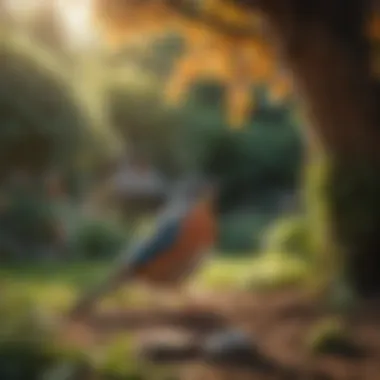
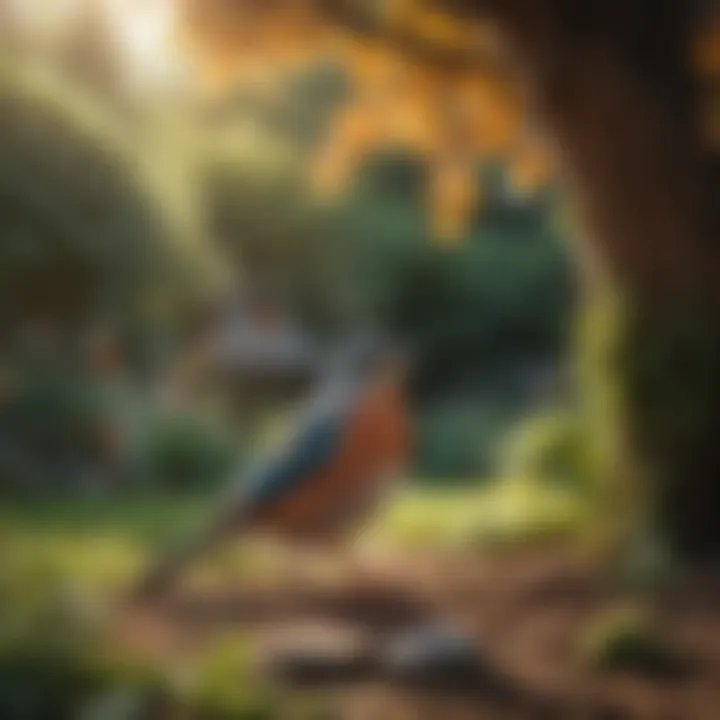
One of the key characteristics of netting is its effectiveness. It creates a physical barrier, ensuring birds cannot reach the areas of concern. This makes netting a highly beneficial choice, especially in sensitive areas like gardens or fruit trees. Unique features of netting give long-lasting protection and do not hinder tree growth.
On the downside, installation can be labor-intensive and may require periodic maintenance to ensure durability. Improper installation could also lead to harm to birds if they become entangled, necessitating careful planning and execution.
Physical Barriers
Physical barriers extend beyond netting to include various forms of fencing or spikes that hinder birds from landing or nesting. These barriers play a significant role in discouraging birds from using trees in undesirable locations.
The key characteristic of physical barriers is their straightforward approach. They clearly signal to birds that a space is off-limits, preventing any potential issues from arising. This makes them a favored choice among property owners looking for immediate solutions. A unique feature is their adaptability; barriers can be customized to suit different tree types and settings.
However, physical barriers may alter the natural landscape, which can be a negative aspect for some. The barriers can also cause issues if not designed properly; they may inadvertently trap birds if incorrectly applied. Thus, a thoughtful approach is crucial in the implementation of these methods.
Natural Predators and Their Role
Understanding the interactions between birds and their natural predators is crucial for effective bird management in trees. Natural predators help to maintain a balance in the ecosystem. They regulate bird populations by preying on species that can become problematic. When the predator-prey dynamics are in balance, a healthier environment emerges. Encouraging predatory bird species can reduce the number of nuisance birds in residential areas while protecting biodiversity.
Encouraging Predatory Bird Species
Promoting the presence of predatory birds can be an effective strategy. Birds of prey, like hawks and owls, can help manage populations of smaller birds that may cause damage to trees or gardens. To encourage these predators, it is important to create suitable habitats:
- Nest Boxes: Installing nest boxes specifically designed for predatory birds can increase their population in the area. This gives them a safe place to raise their young.
- Perching Structures: Setting up perches in open areas can provide hunting spots for these birds. Tall poles or trees are great for this purpose.
- Food Sources: Maintaining a healthy ecosystem that supports small rodents can attract predatory birds. Avoiding rodenticides helps ensure that their prey is plentiful.
By creating an environment that attracts predatory birds, homeowners can enjoy the benefits of natural pest management.
Balancing Predator-Prey Dynamics
Maintaining balance among bird populations requires understanding predator-prey dynamics. These dynamics are often delicate and can shift based on numerous factors. Too many predatory birds can lead to reduced numbers of their prey, potentially harming the ecosystem. Conversely, an excess of prey can cause significant ecological damage.
To achieve this balance, regular monitoring is necessary. Homeowners should observe changes in bird populations over time. This can be done by:
- Bird Watching: Taking note of bird species present in a yard or nearby trees can offer insight into population dynamics.
- Data Recording: Keeping a simple log of bird sightings and behaviors helps in identifying trends.
- Community Engagement: Collaborating with local birding groups can provide valuable information about regional bird populations and their trends.
"Encouraging natural predators is not just about managing nuisance birds, but fostering a balanced ecosystem."
Achieving equilibrium in predator-prey relationships can enhance not only the well-being of your landscape but also contribute to the overall health of local ecosystems, reinforcing the importance of natural strategies in bird management.
Monitoring and Assessing Effectiveness
Monitoring and assessing the effectiveness of bird management strategies is critical for achieving the desired outcomes in tree environments. By systematically evaluating these efforts, homeowners and property managers can determine which methods work best for their specific situations. This section outlines elements that are essential in understanding how to properly monitor bird populations and the impact of management techniques.
One significant benefit of effective monitoring is the ability to adapt strategies to changing bird behavior and environmental conditions. As bird populations fluctuate or amend their habits, ongoing assessment will help ensure that management strategies remain relevant and effective. Additionally, this evaluation can foster a deeper appreciation of local wildlife, as you become more attuned to the dynamic nature of avian interactions with your trees.
Setting Up Tracking Systems
Setting up tracking systems provides a structured approach to observing bird populations and understanding their patterns. It involves utilizing specific methodologies that allow for detailed observations and data analysis.
Observation Techniques
Observation techniques are foundational aspects of effective bird management. These techniques encompass various methods, such as direct observation, the use of binoculars, and video surveillance. The key characteristic of observation techniques is their ability to provide real-time insights into bird behavior, which is invaluable for determining whether management strategies are successful.
One beneficial aspect of direct observation is that it allows property owners to see firsthand how birds interact with their environment. This offers an immediate understanding of species behavior without disruption. On the downside, some may find observation time-consuming and may not capture comprehensive data without systematic approaches. However, consistency in observation can yield profound insights.
Data Collection
Data collection is another vital component of tracking bird populations. This aspect involves gathering quantitative and qualitative data that reflect the bird species' interactions with the trees and surrounding environment. A notable characteristic of data collection is that it can help establish patterns over time, lending credence to the effectiveness of management strategies.
Using surveys or maintaining logs of bird sightings is a common practice and is popular due to its straightforward approach. One unique feature of effective data collection is that it can reveal the seasonal changes in bird populations, indicating when certain species are more likely to cause issues. However, the primary disadvantage is that it requires patience and attention to detail, which some may find challenging.
Evaluating Change Over Time
Evaluating change over time is essential for assessing the long-term impact of the management strategies in place. This evaluation involves comparing data points collected over different periods to ascertain whether the interventions have resulted in improvements or exacerbated existing issues. By carefully analyzing data, one can observe shifts in bird populations and assess whether the strategies applied have positively influenced tree health and local habitats.
Resources and Support for Effective Management
Managing birds in trees requires not only strategies but also access to relevant resources and support systems. For homeowners and individuals who wish to manage bird populations effectively, understanding the availability of professional guidance and agency support is crucial. Such resources help ensure that the management practices implemented are humane, ecologically sound, and effective in addressing the issues caused by birds in trees.
Consulting with Professionals
Engaging with professionals who specialize in wildlife management can significantly enhance the effectiveness of bird management strategies. These experts offer invaluable insights based on scientific data and field experience. They can help homeowners assess bird-related issues accurately and recommend tailored solutions that align with local wildlife regulations.
Professional services may include consultations with ornithologists, ecologists, or pest control experts. Each of these specialists brings a unique perspective on managing bird behavior while minimizing harm to the birds themselves. They may recommend practices that reduce nesting in undesirable areas or suggest methods for enhancing landscape design to deter certain species.
Here are some benefits of consulting with professionals:
- Customized Solutions: Tailored approaches based on specific situations or bird species present.
- Legal Guidance: Professional insight into compliance with local regulations regarding bird protection and management.
- Long-Term Planning: Professionals can help plan sustainable solutions that consider future ecological impacts as well.
Accessing Local Wildlife Agencies
Local wildlife agencies play a key role in providing resources and support for effective bird management. These organizations often have the knowledge, tools, and assistance necessary to address avian management challenges. They may offer educational resources, recommendations for best practices, and even materials for bird deterrence.
By accessing local wildlife agencies, homeowners can:


- Stay Informed: Agencies keep up-to-date with current research and strategies for bird management, ensuring that advice given is based on the latest findings.
- Community Engagement: They often sponsor workshops, information sessions, and community outreach programs to educate the public about coexisting with birds.
- Resource Availability: Many agencies provide brochures, manuals, or online resources that outline effective practices for managing local bird populations.
"Working with professionals and agencies helps create a balanced approach to wildlife management, ensuring both human needs and animal welfare are respected."
Case Studies of Successful Bird Management
Case studies provide practical examples of how bird management strategies can be applied effectively. They highlight real-world situations, demonstrating the impact of various techniques used in different settings. Analyzing these case studies allows homeowners, landscapers, and businesses to learn from others’ experiences. This section focuses on actionable insights derived from specific residential and commercial examples, showcasing how targeted approaches can lead to successful outcomes.
"Understanding what has worked for others can illuminate paths for our own bird management efforts."
Residential Solutions
In residential areas, the presence of birds often brings both joy and frustration. Homeowners benefit from two successful case studies that illustrate effective management methods.
Case Study: Suburban Garden
In a suburban garden plagued by sparrows and starlings, the homeowner decided to take action. They implemented habitat modification by pruning overgrown shrubs and maintaining open spaces in the yard. This approach decreased the availability of shelter, leading to a natural reduction in sparrow nesting. The use of visual deterrents, like reflective tape and plastic owls, proved effective in keeping starlings at bay. Within a few months, the number of birds declined significantly, and the garden thrived again.
- Key Elements:
- Habitat modification through regular maintenance.
- Use of visual deterrents to discourage specific species.
Case Study: Urban Balcony
Another homeowner faced issues with pigeons nesting on their balcony. To address this, they installed netting to physically block access to nesting sites. Additionally, they created an informative sign to remind neighbors not to feed the birds, which can worsen the situation. These actions resulted in a noticeable decrease in pigeon activity over a short period.
- Key Elements:
- Installation of netting to prevent nesting.
- Community awareness through informative materials.
Commercial Properties
Bird management in commercial properties requires a more systematic approach due to the scale and impact on business operations. Two illustrative case studies demonstrate effective strategies.
Case Study: Restaurant Rooftop
A restaurant located in a busy urban area experienced significant issues with pigeons congregating on their rooftop, impacting cleanliness and customer experience. The management opted for a multi-faceted approach. They first installed physical barriers, specifically bird spikes, which prevented pigeons from roosting on ledges. Additionally, they added visual scare devices that moved to create a dynamic deterrent. Over time, not only did the pigeon population decline, but the restaurant also saw improved customer satisfaction.
- Key Elements:
- Use of bird spikes as a physical deterrent.
- Implementation of dynamic visual scare devices for ongoing influence.
Case Study: Office Complex
An office complex with lush landscaping found itself dealing with aggressive feeding behavior from starlings. They enlisted help from local wildlife experts to assess the situation. Together, they developed a holistic management plan that included habitat modification to reduce food sources, along with humane bird deterrents like audio scare devices. The results showed a marked decrease in troublesome bird behavior and a more pleasant environment for employees.
- Key Elements:
- Collaboration with wildlife experts for tailored strategies.
- Implementation of humane deterrents to manage bird presence.
These succesful case studies underline the importance of tailored strategies that consider the specific needs and conditions of each setting. By adopting similar methods, homeowners and businesses can effectively manage birds, creating beneficial environments for both humans and avian species.
Educating the Community on Bird Management
Educating the community about bird management is crucial for maintaining a harmonious relationship between residents and avian species. Many homeowners may not fully understand the ecological roles that birds play in their environment. By learning to appreciate birds, people can be more compassionate and thoughtful in their approaches to managing them in residential areas.
Moreover, proper education can significantly reduce conflicts arising from bird activities. Through knowledge, communities can adopt effective strategies that do not harm birds, yet address issues like noise, droppings, and property damage. Fostering awareness also encourages involvement in local conservation, promoting the well-being of the ecosystem as a whole. Understanding the balance of local wildlife and human needs is essential for sustainable living.
Workshops and Training Sessions
Workshops and training sessions serve as valuable platforms to educate the community about bird management. These sessions can cover a range of topics, such as differentiating between various bird species, understanding their behaviors, and recognizing when intervention is necessary.
Effective workshops should include:
- Basic Bird Identification: Teaching residents to distinguish between birds commonly found in trees allows for better understanding and appreciation.
- Management Techniques: Provide practical solutions for managing bird populations without resorting to harmful practices.
- Legal Guidelines: Offer insights into the legal protections that many bird species have, ensuring compliance with local wildlife regulations.
Using local experts or wildlife conservationists can enhance these sessions. Their knowledge brings legitimacy and can help clarify complex points.
Creating Informative Materials
Creating informative materials complements educational efforts within the community. These resources can take various forms, such as brochures, pamphlets, or online content. They should be easily accessible and cover relevant information about the importance of birds and effective management strategies.
Important content to include:
- Benefits of Birds: Highlighting the ecological advantages of birds, including pest control and pollination.
- Humane Management Techniques: Detailed descriptions of non-lethal methods for deterring birds can arm residents with knowledge they need.
- Local Resources: Links to local wildlife agencies or conservation groups that can provide additional support.
Informative materials should be clear and concise, making it easier for the target audience, particularly homemakers and property owners, to digest the information. Using simple language ensures better understanding across various education levels.
"Educating the community fosters understanding and encourages humane bird management strategies, contributing positively to local ecosystems."
End: The Path Forward
The management of birds in trees is a significant topic for both homeowners and those involved in landscape design. As we have explored throughout this article, birds can provide both benefits and challenges within our ecosystems. The path forward must focus on integrating strategies that consider the need for birds while addressing human concerns. This is particularly important in urban settings where conflicts may arise between avian populations and human activities.
Balancing Human Needs with Avian Life
To effectively balance human needs with avian life, it is crucial for individuals to understand the value birds contribute to their environment. Birds are essential for pollination, pest control, and overall ecosystem health. However, their presence can also lead to conflicts, such as damage to gardens and homes or noisy behavior. To mitigate these issues, residents can implement several strategies:
- Create designated areas for bird habitats. This approach encourages birds to dwell in specific locations away from human spaces.
- Use native plants in landscaping. Native plants provide food and shelter for birds while minimizing the likelihood of aggressive species taking over gardens.
- Educate community members. Understanding bird behavior can help reduce fears or misinterpretations of their actions, fostering a more harmonious coexistence.
By prioritizing communication between neighbors and communities, a more thorough understanding of local avian species can be cultivated. Each species plays a pivotal role in maintaining healthy ecosystems, yet must be managed expertly.
Sustaining Healthy Ecosystems
Sustaining healthy ecosystems requires a proactive approach when managing birds in trees. Ecosystems are interconnected, and each component, including birds, plants, and soil, contributes to overall health. Harmful practices, such as indiscriminate removal of bird populations, can have negative repercussions throughout the ecosystem. To maintain balance, consider the following:
- Promote biodiversity. Encouraging a range of species, including both birds and plants, fortifies ecosystems against pests and diseases.
- Monitor ecosystem health. Regularly assessing local flora and fauna can identify changes that may necessitate management intervention.
- Implement integrated pest management. This strategy minimizes the need for chemical interventions and maintains natural bird populations as a part of the solution.







